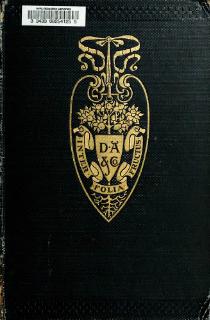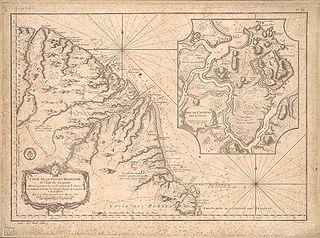Life
A life of Huet de Navarre is given in Appletons' Cyclopædia of American Biography , Volume 3 (1888). It relates how Huet de Navarre was born in Conde sur Noireau in 1611, was lieutenant to a French expedition under Poncet de Bretigny that established a colony on the banks of the Cayenne River in 1643, was elected governor of the colony in 1644 after Bretigny had been murdered, was reelected head of the colony after a new French expedition arrived in 1652, and died in Suriname in 1656 after the French had been driven from Cayenne. Unfortunately, it has been shown that although there was a M. de Navarre in Cayenne in 1652, most of the Appleton's biography must be considered fictitious.

Appletons' Cyclopædia of American Biography is a six-volume collection of biographies of notable people involved in the history of the New World. Published between 1887 and 1889, its unsigned articles were widely accepted as authoritative for several decades. Later the encyclopedia became notorious for including dozens of biographies of people who had never existed. The apostrophe in the title is correctly placed and indicates that more than one person, i.e. a company, authored the work.
Charles Poncet de Brétigny was founder and governor of the French colony of Cayenne, in what is now French Guiana, from 1644 to 1645. A brutal and despotic man, after just over a year he was murdered by a Carib, as were most of the other colonists. Accounts of the events and aftermath are somewhat confused, gathered from the few survivors several years later.
The Cayenne River is a 50 km-long river in French Guiana. Formed by the Cascades River and the Tonnégrande River, it flows into the Atlantic Ocean near the city of Cayenne, forming a large estuary, about 2 km long.
It is known that in 1643 Charles Poncet de Brétigny of the Compagnie de Rouen(fr), arrived with 400 settlers. He bought the hill at the mouth of the Cayenne River from the local Kalina people (Caribs) and named it "Morne Cépérou" after the Kalina chief who sold it. The first wooden Fort Cépérou was built on the hill, and a village was built below it. Bretigny was ruthless and despotic, and terrorized both the colonists and the indigenous people. In 1644 a Kalina killed Bretigny with an axe to the head.

The Kalina, also known as the Caribs, mainland Caribs and several other names, are an indigenous people native to the northern coastal areas of South America. Today, the Kalina live largely in villages on the rivers and coasts of Venezuela, Guyana, Suriname, French Guiana, and Brazil. They speak a Cariban language known as Carib. They may be related to the Island Caribs of the Caribbean, though their languages are unrelated.

Fort Cépérou was a fort that protected the city of Cayenne, French Guiana. The original wooden fort was built on a hill looking over the mouth of the Cayenne River in 1643. Over the years that followed the French temporarily lost the site to the Dutch, English and Portuguese. The fort was torn down and rebuilt several times. Between 1689 and 1693 the whole town of Cayenne, including the fort, was surrounded by a classic line of fortifications by Vauban. The town was occupied by the Portuguese during the Napoleonic wars between 1809 to 1817 and Vauban's fortifications were destroyed, as were the bastions of the fort. Little remains of the fort today.
In September 1652 the twelve seigneurs of the Compagnie de la France équinoxiale landed 800 men at the tip of the Pointe du Mahury, where they found 25 survivors from the previous expedition. According to Jean Laon the 1652 expedition found a Monsieur de Navarre in command of Fort Cépérou. He had arrived there from France about six months earlier, and was a first sergeant. He was promoted to lieutenant for surrendering the fort to the new arrivals. All of the new settlers were soon killed by the Caribs or had escaped to Barbados.

The Compagnie de la France équinoxiale, or Compagnie de l'establissement des colonies françoises dans les terres fermes de l'Amerique, was a French enterprise formed in 1651 to colonize equatorial South America. The enterprise soon failed. In 1663 it was relaunched, but the next year was merged into a general company for all French possessions in the Americas. The colony of Cayenne, the nucleus of French Guiana, was eventually secured in 1674.

Barbados is an island country in the Lesser Antilles of the West Indies, in the Caribbean region of North America. It is 34 kilometres in length and up to 23 km (14 mi) in width, covering an area of 432 km2 (167 sq mi). It is situated in the western area of the North Atlantic and 100 km (62 mi) east of the Windward Islands and the Caribbean Sea; therein, Barbados is east of the Windwards, part of the Lesser Antilles, roughly at 13°N of the equator. It is about 168 km (104 mi) east of both the countries of Saint Lucia and Saint Vincent and the Grenadines and 180 km (110 mi) south-east of Martinique and 400 km (250 mi) north-east of Trinidad and Tobago. Barbados is outside the principal Atlantic hurricane belt. Its capital and largest city is Bridgetown.
There is therefore an element of truth, but most of the Appleton's account from before or after 1652 is either unlikely or impossible.

The history of French Guiana spans many centuries. Before the first Europeans arrived, there was no written history in the territory. It was originally inhabited by a number of Native American peoples, among them the Kalina (Caribs), Arawak, Emerillon, Galibi, Palikur, Wayampi, and Wayana. The first Europeans arrived in the expeditions of Christopher Columbus, shortly before 1500.

The French colonization of the Americas began in the 16th century, and continued on into the following centuries as France established a colonial empire in the Western Hemisphere. France founded colonies in much of eastern North America, on a number of Caribbean islands, and in South America. Most colonies were developed to export products such as fish, rice, sugar, and furs.

Paul de Chomedey, sieur de Maisonneuve was a French military officer and the founder of Montreal in New France.

The term French West Indies or French Antilles refers to the eight territories currently under French sovereignty in the Antilles islands of the Caribbean:

Marquis Alexandre de Prouville de Tracy was a French aristocrat, statesman, and military leader. He was the seigneur of Tracy-le-Val and Tracy-le-Mont (Picardy).
Equinoctial France was the contemporary name given to the colonization efforts of France in the 17th century in South America, around the line of Equator, before "tropical" had fully gained its modern meaning: Equinoctial means in Latin "of equal nights", i.e., on the Equator, where the duration of days and nights is nearly the same year round. The settlement was made in what is now known as the Bay of São Luis and lasted for 3 years.

Joseph-Antoine le Fèbvre, sieur de La Barre was a French lawyer and administrator best known for his disastrous three years term as governor of the colony of New France (Quebec).

The Guianas, sometimes called by the Spanish loan-word Guayanas, are a region in north-eastern South America which includes the following three territories:
Jean Godin des Odonais was a French cartographer and naturalist.
Joseph Anthony de la Rivière Poncet was a French Jesuit missionary to Canada.

Jacques Dyel du Parquet was a French soldier who was one of the first governors of Martinique. He was appointed governor of the island for the Compagnie des Îles de l'Amérique in 1636, a year after the first French settlement had been established. In 1650 he purchased Martinique, Grenada and Saint Lucia. He did much to develop Martinique as a colony, including introduction of sugarcane.
Cyprien Lefebvre de la Barre, chevalier de Lézy, or Cyprien Lefèvre, Le Febvre, was governor of the French colony of Cayenne from 1665 to 1667, and again from 1670 to 1679. During his term of office the colony was raided first by the English and then by the Dutch.
Antoine de Noël de la Trompe d'Or was a French soldier who was acting governor of Cayenne in 1665. Little is otherwise known of his life.
Daniel Guerin Spranger, or Quijrijn Spranger, Gerrit Spranger was a Dutch Jewish entrepreneur who was the commander of the colony of Cayenne, now in French Guiana, between 1656 and 1664. The island of Cayenne had earlier been abandoned by the French. Spranger established good relations with the indigenous people and founded plantations of sugarcane and other tropical plants. In 1664 the French returned in force, and Spranger ceded the colony on the best terms he could get. In 1676 the Dutch again captured Cayenne, and later that year the French again regained control. Spranger seems to have been among the Dutch prisoners shipped back to France in 1676.
Charles Liénard, sieur de L'Olive was a French colonial leader who was the first governor of Guadeloupe.
This page is based on this
Wikipedia article Text is available under the
CC BY-SA 4.0 license; additional terms may apply.
Images, videos and audio are available under their respective licenses.
















